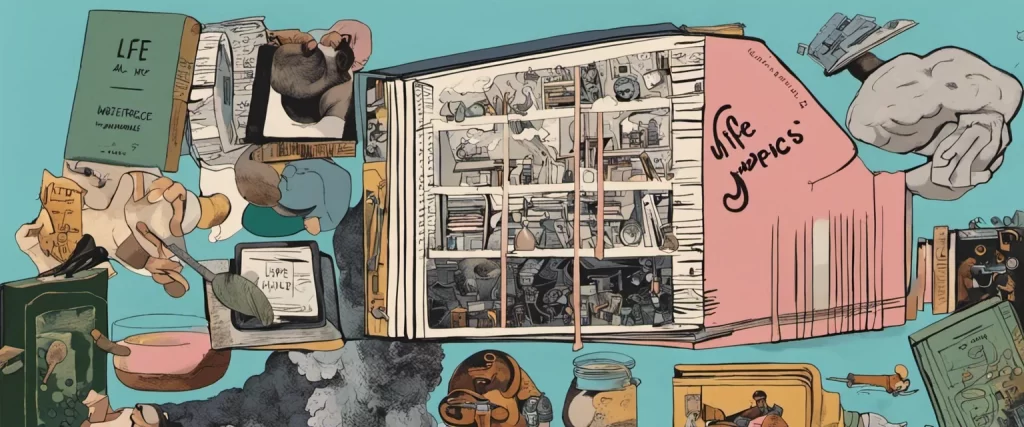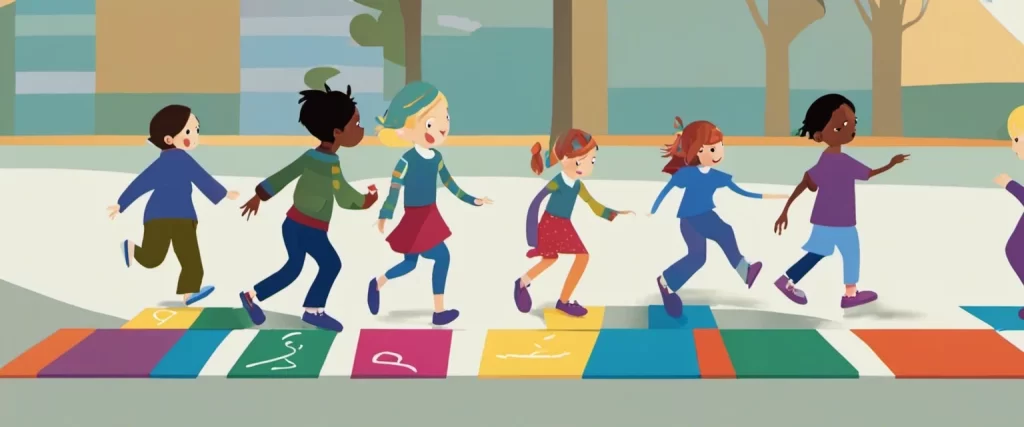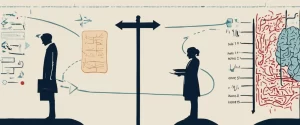—Hopscotch & Life: A User’s Manual
In the realm of literary innovation, where words craft intricate universes and narrative boundaries are pushed and shattered, two remarkable works stand out as masterpieces of experimentation and exploration. “Hopscotch” by Julio Cortázar and “Life: A User’s Manual” by Georges Perec have established themselves as iconic landmarks in the realm of metafiction, each uniquely challenging traditional narrative structures to present a captivating and thought-provoking literary experience.
Published in 1963, “Hopscotch” introduces readers to a labyrinthine narrative structure that reflects the complexities of human existence. Fusing elements of fiction, philosophy, and game theory, Cortázar’s work invites readers to engage with its intricate web of interconnected chapters and narrative paths. With its famously non-linear structure, the novel offers multiple reading approaches, including a suggested “hopscotch” reading order or a non-linear, randomly chosen chapter sequence, pushing readers to actively participate in shaping the interpretation of the story.
On the other hand, “Life: A User’s Manual,” published in 1978, showcases Georges Perec’s immense literary prowess by unraveling the intricate tapestry of a Parisian apartment building and its inhabitants. Perec’s magnum opus embraces a meticulous structure, employing a strict set of constraints that captivate readers right from the opening pages. As an exemplar of the Oulipo literary movement, Perec artfully intertwines chance, mathematical principles, and exhaustive detailing to unravel the secrets, histories, and idiosyncrasies concealed within the walls of 11 Rue Simon-Crubellier.
Both Cortázar and Perec, in their unmistakable ways, transcend traditional storytelling boundaries. Their works challenge readers to question the very nature of narrative coherence, linear time, and the role of the reader in shaping the meaning of a text. Through divergent approaches and unique narrative structures, Cortázar and Perec offer readers an opportunity to break free from the shackles of conventional storytelling, plunging headlong into a literary adventure that tests the limits of imagination and comprehension.
This comparative study aims to delve into the interplay of narrative experimentation, thematic undertones, and the philosophical implications embedded within the pages of “Hopscotch” and “Life: A User’s Manual.” By closely examining the authors’ narrative techniques, character development, and the portrayal of their respective constructed worlds, we will explore how these two literary giants have revolutionized the artistic landscape, leaving an indelible mark on the genre of metafiction.
As we embark on this comparative odyssey, we shall navigate the depths of their labyrinthine narratives, decipher the hidden meanings and allusions, and ultimately unravel the profound insights into human existence and the art of storytelling that lie within the pages of “Hopscotch” and “Life: A User’s Manual.”
Brief Summary of Two Books
Hopscotch by Julio Cortázar
“Hopscotch” by Julio Cortázar is a complex and experimental novel that follows the intertwined lives of a group of intellectuals and bohemians living in Paris during the 1950s. The story revolves around Horacio Oliveira, an Argentine writer trying to find meaning amidst the chaos of his city and relationships. The novel has an unconventional structure, with multiple possible orders to read the chapters, allowing readers to explore different paths and perspectives. Themes of existentialism, freedom, and the search for identity are explored through metaphysical discussions, literary references, and intricate character development. Ultimately, “Hopscotch” challenges traditional narrative conventions and invites readers to embrace their own interpretation and engagement with the text.
Life: A User’s Manual by Georges Perec
Life: A User’s Manual is a richly intricate novel by Georges Perec that explores the diverse lives and stories of the residents living in an old Parisian apartment building. The book consists of ten chapters, with each chapter focusing on a different room or object in the building, and each room revealing the hidden stories and secrets of the individuals who inhabit the various spaces. Through a mosaic of interconnected narratives, Perec touches upon themes of love, loss, memory, and the complexity of human existence. The book serves as a metaphorical puzzle where readers unravel the intricate lives of the characters, and as an ode to the beauty and complexity of the everyday.
Comparison between Two Books

Similarities in storytelling techniques
In both “Hopscotch” by Julio Cortázar and “Life: A User’s Manual” by Georges Perec, the authors incorporate unique storytelling techniques that captivate the readers. Despite their distinctive styles and narratives, there are similarities in these techniques that enhance the novel’s structure and engage the audience.
One similarity lies in the exploration of non-linear storytelling. Both authors abandon traditional linear narratives, instead opting for fragmented structures that challenge the reader’s conventional reading habits. In “Hopscotch,” Cortázar presents multiple possible paths for reading the book, allowing the reader to choose their own sequence of chapters. Likewise, Perec’s “Life: A User’s Manual” is structured as a puzzle, with each chapter devoted to a different room in a Parisian apartment building, providing snapshots of various characters’ lives. This non-linear approach allows the authors to experiment with narrative possibilities and encourages the reader’s active engagement in constructing the story.
Moreover, both novels employ intertextuality as a narrative technique. Cortázar and Perec make references to other works of literature, incorporating them into their own narratives. In “Hopscotch,” Cortázar includes quotations and references to prominent authors like Edgar Allan Poe and Marcel Proust. Perec, on the other hand, intertwines the lives of his characters with puzzles and allusions to various artistic works, including painting and music. By incorporating intertextuality, these authors create a rich literary tapestry that expands beyond their own narratives, inviting readers to explore different artistic realms.
Additionally, Cortázar and Perec effectively employ the element of surprise in their storytelling techniques. Both authors skillfully manipulate the reader’s expectations, playing with narrative conventions and defying anticipations. Cortázar’s “Hopscotch” includes various narrative detours, dreamlike sequences, and unexpected plot developments. Similarly, Perec toys with the reader’s assumptions through intricate plot twists and surprises in “Life: A User’s Manual,” revealing hidden connections between the characters and catching the readers off guard. These unexpected turns amplify the tension and add an element of mystery, keeping the readers engaged and eager to uncover the secrets woven into the narratives.
In conclusion, while “Hopscotch” by Julio Cortázar and “Life: A User’s Manual” by Georges Perec differ in many aspects, they share some remarkable similarities in storytelling techniques. Both novels embrace non-linear narratives, utilize intertextuality, and employ surprising plot developments to captivate their readers. These techniques highlight the authors’ mastery of their craft, challenging conventional storytelling norms and offering readers an innovative and unconventional reading experience.
Divergences in storytelling techniques
Hopscotch by Julio Cortázar and Life: A User’s Manual by Georges Perec are both noteworthy literary works that experiment with narrative techniques and challenge conventional storytelling. However, they differ in their approaches to storytelling and the techniques employed.
Hopscotch explores the concept of nonlinearity and reader interaction. The novel presents multiple reading paths, with the author suggesting several possible sequences of chapters to follow. This invites the reader to actively participate in the construction of the narrative and allows for a non-linear reading experience. Cortázar’s storytelling technique is characterized by fragmentation, symbolism, and the mixing of different genres (such as detective fiction and philosophical musings) into a single narrative. The novel also incorporates elements of game theory and existentialism, adding an extra layer of complexity to the storytelling.
On the other hand, Life: A User’s Manual follows a more traditional storytelling structure, albeit with a twist. Perec constructs a detailed and intricate narrative that revolves around an apartment building and its inhabitants. Each chapter focuses on a different room and its objects, while also introducing the inhabitants’ stories and connections. The novel is structured like a puzzle, with the narrative progressing in a chess-like pattern across the rooms. Perec’s storytelling technique involves meticulous descriptions of objects and their histories, creating a sense of a fragmented yet interconnected world.
The divergence in storytelling techniques between these two books is primarily rooted in the ways they engage with the reader. While Hopscotch demands reader participation and agency in navigating the narrative, Life: A User’s Manual presents a pre-determined puzzle-like structure for readers to unravel. Cortázar’s novel challenges the traditional linear approach to storytelling and forms an interactive relationship with the reader. In contrast, Perec’s work provides a complex narrative architecture but offers limited room for reader input or interpretation.
In conclusion, the divergence in storytelling techniques between Hopscotch by Julio Cortázar and Life: A User’s Manual by Georges Perec lies in their respective approaches to reader interaction and the structure of the narratives. Cortázar’s work invites readers to actively participate in constructing the story and explores nonlinearity, symbolism, and genre mixing. Meanwhile, Perec’s novel presents a carefully planned puzzle-like structure, offering intricate descriptions and a sense of interconnectedness. Both works challenge conventional storytelling methods but do so in distinct ways.

Conclusion
Both “Hopscotch” by Julio Cortázar and “Life: A User’s Manual” by Georges Perec are highly regarded and critically acclaimed novels. The choice of which one is more worthy of reading ultimately depends on personal preferences and interests.
“Hopscotch” is a nonlinear and experimental novel that offers multiple narrative paths and allows readers to choose their own reading experience. It explores themes such as existentialism, love, and the search for meaning. This book is known for its innovative storytelling structure, various literary techniques, and philosophical depth. If you enjoy thought-provoking and unconventional narratives, “Hopscotch” may be the more worthy choice for you.
On the other hand, “Life: A User’s Manual” is a complex and intricate puzzle-like novel that delves into the lives of the residents in a Parisian apartment building. It weaves together multiple storylines, historical references, and intricate descriptions of objects to create a rich tapestry of interconnected lives. This book is praised for its meticulous attention to detail, intricate storytelling, and exploration of human existence. If you appreciate intricate and carefully crafted narratives, “Life: A User’s Manual” might be the more worthy option for you.
Both books have their merits and provide unique reading experiences. It is recommended to read synopses, reviews, and excerpts of both novels to get a better sense of which one aligns more with your personal tastes and interests. Ultimately, the decision of which book is more worthy of reading will be subjective to your own preferences.



